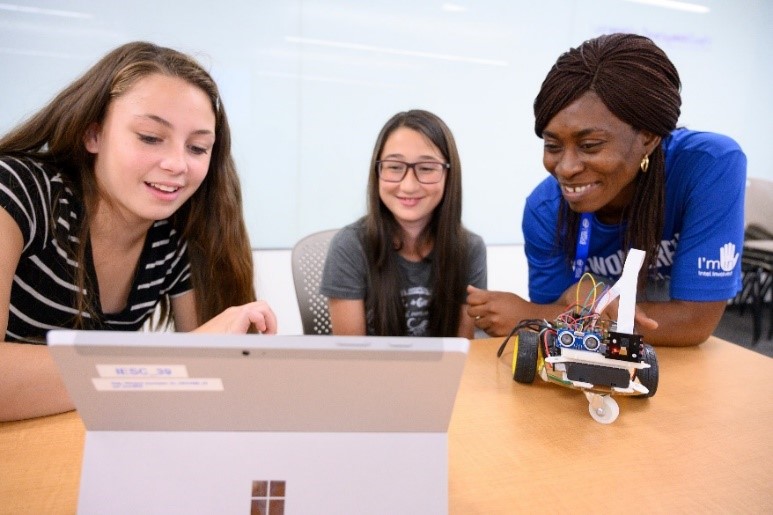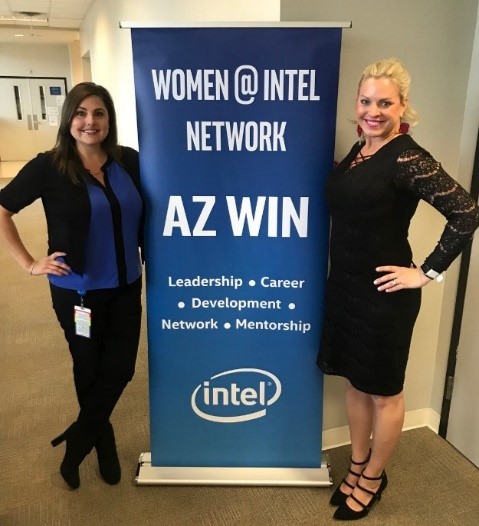Initiative Spotlight
Intel’s Women Initiatives
Building the pipeline of female leaders in technology
As Intel aims to increase the number of women in senior leadership and technical roles this decade, a look at its programs to support women inside and outside the company. One such community, the Women at Intel (WIN) Network, celebrates its 25th anniversary in 2021.
Intel has been taking meaningful steps to support the advancement and retention of women for decades. Intel’s purpose as a company — to create world-changing technology that enriches the lives of every person on earth — is underpinned by its cultural value of inclusion. The company’s stated ambition to be the most inclusive company in the world cannot be accomplished without a focus on supporting female employees. One standout and long-running program is the Women at Intel (WIN) Community, a network with a strong commitment to empowering the next generation of the female tech workforce.

In 2021, the Women at Intel Network (WIN) will celebrate its 25th anniversary. Today, the community connects over 7,500 members at 88 different locations spread around Intel’s global operations. “Being a part of WIN over the last decade has been a catalyst for amazing things in my career,” says Shelly Lafree, WIN’s Cross-Site Chair and longtime member. “My network has increased exponentially, as the work we do within WIN spans all business groups and campuses at Intel. WIN has connected me to amazing people and leaders across the company who I’ve leveraged as references for key roles — as well as coaches when I was in need of support.”
Operating in parallel with WIN is Intel’s Network of Executive Women (INEW), a council of the senior-most women and partners at the company, as well as other communities such as the Black Network of Executive Women (BNEW) and the Latin American Region Network of Executive Women (LARNEW).
Intel’s commitment to women doesn’t just cover its current workforce. The company has several programs in place that work to build the global pipeline of young girls pursuing careers in STEM, empowering them through technology skills and hands-on experiences. For instance:
-
In 2015, the Intel Foundation partnered with the U.S. State Department and the United Nations Foundation to create the Girl Up Women in Science (WiSci) program. WiSci seeks to bridge the gender gap in STEAM fields through access to education, mentorship opportunities and leadership training — in part through STEAM camps, facilitated by Intel Employee Service Corps volunteers, which have been held in Rwanda, Estonia, Namibia and other countries.
-
As part of the Intel® She Will Connect program, the Intel Foundation recently joined forces with several other organizations to launch Million Girls Moonshot, a movement designed to help close the science and engineering gender gap by engaging one million school-age girls in STEM learning opportunities over the next five years across all 50 U.S. states.
-
Intel is a foundational member of the Reboot Representation Tech Coalition — which is supported by Pivotal Ventures, an investment and incubation company started by Melinda Gates — and has committed to doubling the number of Black, Latinas and Native American women graduating with computing degrees by 2025.

The future is bright for Intel’s work to empower women — both inside and outside of the company. As part of its 2030 corporate responsibility goals, Intel has committed to doubling the number of women and underrepresented minorities in senior leadership roles, in addition to reaching 40% representation of women in technical roles by the end of the decade. A diverse workforce and inclusive culture are key to Intel’s evolution and its ability to continue to attract the best talent to join the company for decades to come.
This Intel-contributed content was originally published as part of the Boston College Center for Work & Family’s Executive Briefing Series, which focused Women’s Career Advancement Programs. Read their full report.
